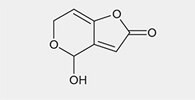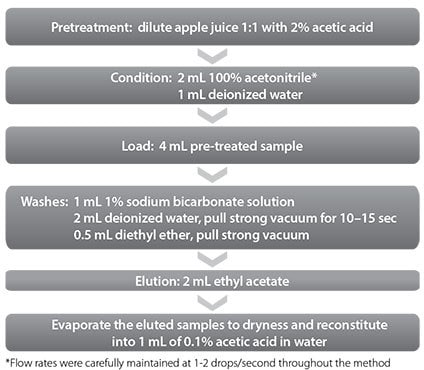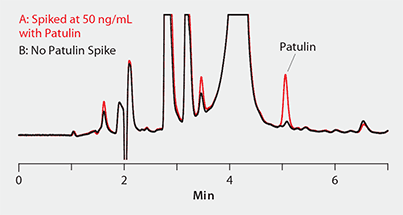Selective Extraction and Cleanup of Patulin Mycotoxin from Apple Juice Samples
Olga Shimelis, K. G. Espenschied, Jennifer Claus
Reporter US, Volume 32.1
Using Molecularly Imprinted Polymer SPE and Ascentis® Express HPLC-UV Analysis
Introduction
Patulin (Figure 1) is a mycotoxin produced by a number of fungal species. The mold Penicillium Expansum, in particular, is known as the main source of patulin contamination1. Patulin occurrence is found most often in rotting apples and products made from spoiled apples. Included among these products is apple juice and apple puree2.

Figure 1.Structure of Patulin
Because studies have shown that patulin possesses immunotoxic and genotoxic properties, regulatory limits for patulin have been set in 50 countries, including USA and European Union. In Europe, the maximum limit recommended for patulin in fruit juices is 50 µg/kg. The maximum patulin level permitted by the US FDA in apple juice is 50 µg/L2-4.
Historically, analytical methods for patulin have employed liquid-liquid extraction (LLE) followed by HPLC separation with UV detection at 276 nm1,5. Researchers have highlighted problems with these methodologies, including:
- Tedious sample preparation associated with liquid-liquid extraction
- Patulin instability in alkaline conditions resulting from sodium carbonate cleanup
- The requirement of extra cleanup or chromatographic method development to prevent the coelution of patulin and interfering matrix component 5-hydroxymethylfurfural (HMF)1,6
Therefore, a quick, simple and robust sample preparation method for patulin analysis is needed.
Molecularly Imprinted Polymers
SupelMIP® SPE – Patulin, a sample cleanup product used in this application, is made using the technology of molecularly imprinted polymers (MIPs). During MIP synthesis, a polymerization takes place around a template molecule that is similar to the analyte of interest. This template guides the formation of specific cavities within the polymer that are sterically and chemically complimentary to the target analyte. The subsequent removal of the template results in a polymer that is selectively retentive for the specific analyte of interest.
During sample preparation, the MIP phase extracts the target analyte with a high degree of selectivity. The use of vigorous washes during the SPE procedure results in superior cleanup, producing a highly pure, concentrated sample for analysis. In this application, the use of SupelMIP SPE – Patulin is demonstrated for the cleanup of patulin in apple juice. Please note that other applecontaining products and matrices can be analyzed using similar methodology.
Experimental
The extraction process for patulin from apple juice is described in Figure 2. The SPE drop rate was controlled at 1–2 drops per second. The experiment was done with a replicate of 6 apple juice spikes. Analysis was performed by HPLC-UV with an Ascentis® Express C18 column. Recovery was calculated and corrected for patulin found in the unspiked apple juice.

Figure 2.SPE Procedure for Patulin Extraction and Cleanup
Results and Discussion
This MIP phase SPE procedure yielded high analyte recovery with excellent reproducibility. The average recovery of patulin was calculated to be 84% with a relative standard deviation (RSD) of 2%.
As seen in Figure 3, chromatographic analysis showed that no direct interferences with patulin detection were observed. Unlike LLE procedures, the cleanup procedure using SupelMIP SPE – Patulin successfully removed HMF and other common interfering components from the final extract.

Figure 3.Chromatograms of Apple Juice after SPE Cleanup
The procedure provided a stable solution for patulin analysis. Although the sodium bicarbonate wash was necessary to perform during the SPE protocol, the final extract was acidified, contributing to patulin stability during analysis.
Due to the nature of the MIP phase extraction procedure, a highly concentrated patulin sample was produced for LC-UV analysis. As a result, patulin was easily detectable in apple juice at concentrations of 50 ng/mL. A concentration of 16 ng/mL of incurred patulin was quantified in the blank sample.
Conclusions
The study successfully demonstrated the use of SupelMIP SPE – Patulin for the cleanup and pre-concentration of patulin from apple juice. By selectively extracting patulin with the use of molecularly imprinted polymers and effectively removing interfering matrix compounds during the SPE washing procedure, HPLC-UV analysis of patulin was made possible. The MIP procedure also allowed trace amounts of patulin to be easily detected in apple juice with high analyte recovery and reproducibility. In conclusion, the use of SupelMIP SPE – Patulin for sample cleanup eliminates the aforementioned problems associated with liquid-liquid extraction and provides a fast, easy and reliable sample preparation method for patulin analysis in apple juice.
References
続きを確認するには、ログインするか、新規登録が必要です。
アカウントをお持ちではありませんか?